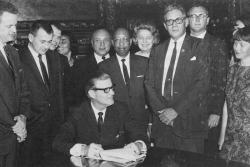

Governor Harold Levander (seated) signs the Minnesota State Act Against Discrimination into law in 1967. It was renamed the Minnesota Human Rights Act in 1973.
Minnesota enacted its first major human rights law in 1967. That statute made it unlawful to discriminate against people based on race, color, creed, and national origin in unions, employment, education, public services, and public accommodations. Over the next twenty-five years DFL legislators tried and failed six times to amend the law to add sexual orientation. They succeeded in 1993.
The 1967 Minnesota State Act Against Discrimination consolidated and strengthened existing anti-discrimination laws and created a new state Department of Human Rights. It was sponsored by Conservatives in the legislature (party designation was banned at the time) and supported by other prominent Conservatives, including Governor Harold Levander, future US Senator David Durenberger, and future federal judge Robert Renner. The law, which forbade discrimination based on race, color, creed, religion, and national origin, had support from both political parties and passed easily. The inclusion of gay rights was not considered—nor was the category of sex added until 1969.
In the 1973 legislative session DFL senate majority leader Nicholas Coleman, on his own and without notice, proposed to amend the law to add people of “homosexual orientation” to those protected. His amendment narrowly passed the senate but was removed in conference with the House of Representatives. However, the categories marital status, status with respect to public assistance, and disability were added that year. The law’s name was also changed to the Minnesota Human Rights Act (MHRA).
In the 1975 legislative session Coleman re-introduced the gay rights (“affectional preference” in this version) amendment to the MHRA that had failed in 1973. This time it got a vote first in the House of Representatives, and lost there 68-51. Coleman then withdrew his Senate bill. Factors in this loss were divisions in the gay community and radical demonstrations in the capitol that repelled some legislators.
Senator Allan Spear, elected in 1972, worked only behind the scenes on the 1973 and 1975 bills, but he took a more active and public role after coming out as gay in December 1974. He was the first Minnesota legislator to do so. In 1977 Spear took over as chief sponsor of the MHRA gay rights amendment, which was defeated again.
By now, conservative religious and anti-gay groups had organized effective opposition to gay rights proposals. Then, in the early 1980s, the HIV/AIDS epidemic added an element of fear and condemnation to the gay community generally. Still, in 1980, voters in Minneapolis elected Karen Clark the first openly lesbian member of the state House of Representatives. In 1983 she and Senator Spear tried again, but their MHRA amendment failed again.
No one introduced gay rights legislation in the sessions 1985 through 1989. In 1990, DFL governor Rudy Perpich appointed a Governor’s Task Force on Gay and Lesbian Minnesotans. The resulting report concluded that “gays and lesbians are the targets of considerable discrimination in the State of Minnesota,” including job loss and violence, and recommended that Minnesota “prohibit discrimination against any person because of sexual orientation.” Nevertheless, a gay rights amendment to the MHRA failed in the 1991 legislature.
Its proponents brought up a new version in the 1993 session. A new lobbying group, It’s Time Minnesota, had organized broad popular support for it and enlisted labor unions, businesses, universities, and prominent civic groups like the League of Women Voters. Republican Governor Arne Carlson had supported the proposed legislation for years. The bill passed in the senate by 37-30, aided by the Senate’s Republican minority leader, Dean Johnson, who made a passionate speech explaining his support (five Republicans voted for it, thirteen DFLers opposed.) The bill passed easily in the House, 78-55, and was signed into law on April 2, making Minnesota the eighth state to enact such a statute. Another factor in this success was dogged persistence over more than twenty years.
The revised, 1993 version of the MHRA prohibited discrimination in employment, labor unions, housing, education, public services, government services, credit, business services, and public accommodations because of “race, color, creed, national origin, sex, marital status, disability. [and] sexual orientation. ” The categories age, familial status, and status with regard to public assistance appeared in only some of the prohibitions. The statute’s definition of sexual orientation included transgender people through the language, “having or being perceived as having a self-image or identity not traditionally associated with one’s biological maleness or femaleness.” A subsequent amendment passed in 2023 separated gender identity from sexual orientation.